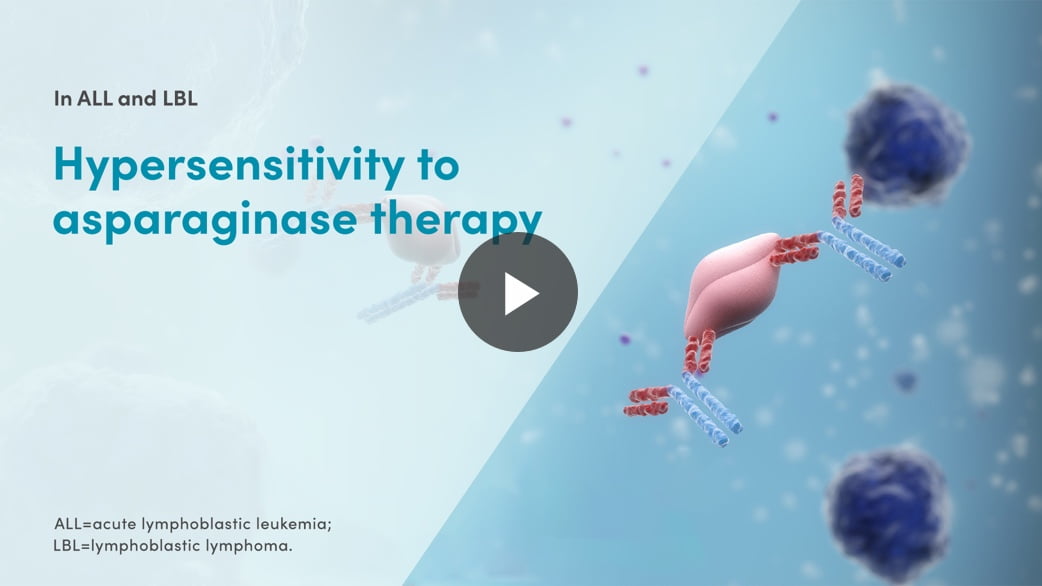Indication
RYLAZE is indicated as a component of a
multi-agent
chemotherapeutic regimen given by intramuscular injection for the treatment of acute lymphoblastic
leukemia (ALL) and lymphoblastic lymphoma (LBL) in adult and pediatric patients 1 month or
older who have developed hypersensitivity to E. coli-derived asparaginase.
IMPORTANT
SAFETY INFORMATION
Contraindications
RYLAZE is contraindicated in patients with:
-
History of serious hypersensitivity reactions to
Erwinia asparaginase,
including anaphylaxis
-
History of serious pancreatitis during previous asparaginase therapy
-
History of serious thrombosis during previous asparaginase therapy
-
History of serious hemorrhagic events during previous asparaginase therapy
-
Severe hepatic impairment
Warnings and Precautions
Hypersensitivity Reactions
Hypersensitivity reactions after the use of RYLAZE occurred in 29% of patients in clinical trials,
and it was severe in 6% of patients. Anaphylaxis was observed in 2% of patients after intramuscular
administration. Discontinuation of RYLAZE due to hypersensitivity reactions occurred in 5% of
patients. Hypersensitivity reactions were higher in patients who received intravenous asparaginase
erwinia chrysanthemi (recombinant)-rywn. The intravenous route of administration is not approved.
In patients administered RYLAZE intramuscularly in clinical trials, the median number of doses of
RYLAZE that patients received prior to the onset of the first hypersensitivity reaction was
12 doses (range:
1-64 doses).
The most commonly observed reaction was rash (19%), and 1 patient (1%) experienced a severe
rash.
Hypersensitivity reactions observed with
L-asparaginase
class products include angioedema, urticaria, lip swelling, eye swelling, rash or erythema, blood
pressure decreased, bronchospasm, dyspnea, and pruritus.
Premedicate patients prior to administration of RYLAZE as recommended. Because of the risk of
serious allergic reactions (e.g., life-threatening anaphylaxis), administer RYLAZE in a setting with
resuscitation equipment and other agents necessary to treat anaphylaxis (e.g., epinephrine, oxygen,
intravenous steroids, antihistamines). Discontinue RYLAZE in patients with serious hypersensitivity
reactions.
Pancreatitis
Pancreatitis, including elevated amylase or lipase, was reported in 20% of patients in clinical
trials of RYLAZE and was severe in 8%. Symptomatic pancreatitis occurred in 7% of patients, and it
was severe in 6% of patients. Elevated amylase or lipase without symptomatic pancreatitis was
observed in 13% of patients treated with RYLAZE. Hemorrhagic or necrotizing pancreatitis have been
reported with
L-asparaginase
class products.
Inform patients of the signs and symptoms of pancreatitis, which, if left untreated, could be fatal.
Evaluate patients with symptoms compatible with pancreatitis to establish a diagnosis. Assess serum
amylase and lipase levels in patients with any signs or symptoms of pancreatitis. Discontinue RYLAZE
in patients with severe or hemorrhagic pancreatitis. In the case of mild pancreatitis, withhold
RYLAZE until the signs and symptoms subside and amylase and/or lipase levels return to
1.5 times the ULN. After resolution of mild pancreatitis, treatment with RYLAZE may be resumed.
Thrombosis
Serious thrombotic events, including sagittal sinus thrombosis and pulmonary embolism, have been
reported in 1% of patients following treatment with RYLAZE. Discontinue RYLAZE for a thrombotic
event, and administer appropriate antithrombotic therapy. Consider resumption of treatment with
RYLAZE only if the patient had an uncomplicated thrombosis.
Hemorrhage
Bleeding was reported in 25% of patients treated with RYLAZE, and it was severe in 2%. Most commonly
observed reactions were bruising (12%) and nose bleed (9%).
In patients treated with
L-asparaginase
class products, hemorrhage may be associated with increased prothrombin time (PT), increased partial
thromboplastin time (PTT), and hypofibrinogenemia. Consider appropriate replacement therapy in
patients with severe or symptomatic coagulopathy.
Hepatotoxicity, including Hepatic Veno-Occlusive Disease
Elevated bilirubin and/or transaminases occurred in 75% of patients treated with RYLAZE in clinical
trials, and 26% had Grade ≥3 elevations. Elevated bilirubin occurred in 28% of patients treated
with RYLAZE in clinical trials, and 2% had Grade ≥3 elevations. Elevated transaminases occurred
in 73% of patients treated with RYLAZE in clinical trials, and 25% had Grade ≥3 elevations.
Hepatotoxicity, including severe, life-threatening, and potential fatal cases of hepatic
veno-occlusive disease (VOD), have been observed in patients treated with asparaginase class
products in combination with standard chemotherapy, including during the induction phase of
multiphase chemotherapy. Do not administer RYLAZE to patients with severe hepatic impairment. Inform
patients of the signs and symptoms of hepatotoxicity.
Evaluate bilirubin and transaminases prior to each cycle of RYLAZE and at least weekly during cycles
of treatment that include RYLAZE, through four weeks after the last dose of RYLAZE. Monitor
frequently for signs and symptoms of hepatic VOD, which may include rapid weight gain, fluid
retention with ascites, hepatomegaly (which may be painful), and rapid increase of bilirubin. For
patients who develop abnormal liver tests after RYLAZE, more frequent monitoring for liver test
abnormalities and clinical signs and symptoms of VOD is recommended. In the event of serious liver
toxicity, including VOD, discontinue treatment with RYLAZE and provide supportive care.
Adverse Reactions
The most common adverse reactions (incidence >20%) with RYLAZE are abnormal liver test, nausea,
musculoskeletal pain, infection, fatigue, headache, febrile neutropenia, pyrexia, hemorrhage,
stomatitis, abdominal pain, decreased appetite, drug hypersensitivity, hyperglycemia, diarrhea,
pancreatitis, and hypokalemia.
Use in Specific Populations
Pregnancy and Lactation
RYLAZE can cause fetal harm when administered to a pregnant woman. Advise females of reproductive
potential to use effective
non-hormonal
contraceptive methods during treatment with RYLAZE and for 3 months after the last dose. Advise
women not to breastfeed during treatment with RYLAZE and for 1 week after the last dose.
Please see full
Prescribing Information.






